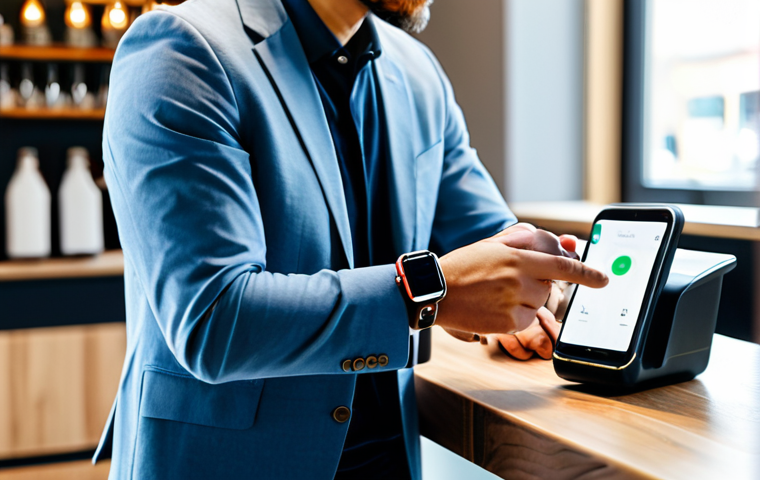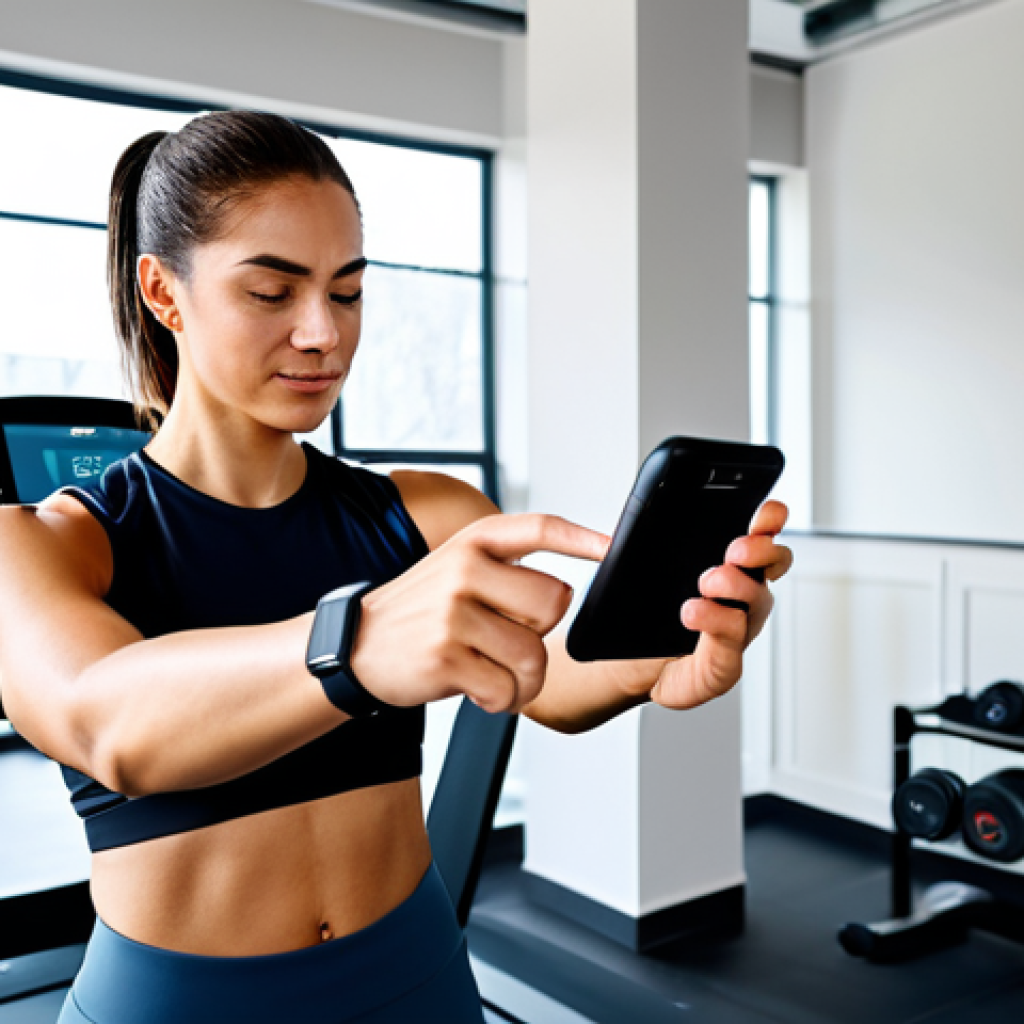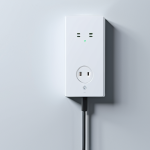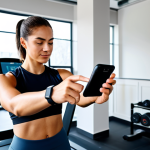Remember when smartwatches felt like something straight out of a sci-fi movie? Just a few years ago, I honestly thought they were a bit gimmicky, an unnecessary addition to my already tech-laden life.
But frankly, my perspective has completely shifted. For me, the real game-changer wasn’t just about getting notifications on my wrist; it was the subtle, yet profound, way it started integrating into my daily health routine.
Suddenly, tracking my steps wasn’t a chore, and monitoring my sleep provided actual, actionable insights. I still recall the first time my watch buzzed to remind me to stand up – a tiny nudge that made a surprisingly big difference during a long workday.
Today, these tiny computers are evolving at lightning speed, far beyond simple fitness trackers. We’re seeing incredible advancements, from more precise heart rate monitoring to emerging features like blood pressure and even continuous glucose monitoring potentially becoming standard.
The buzz around AI integrating further into these devices, making them true health companions that learn from our patterns, is absolutely electrifying.
However, with this power comes the inevitable discussion around data privacy and battery life – crucial considerations for anyone diving into the market.
Choosing the right one can feel like navigating a maze, given the sheer variety and constant influx of new models. It’s not just about features anymore; it’s about finding that perfect blend of functionality, style, and peace of mind that truly enhances your daily flow without adding more digital noise.
Let’s explore this accurately.
Remember when smartwatches felt like something straight out of a sci-fi movie? Just a few years ago, I honestly thought they were a bit gimmicky, an unnecessary addition to my already tech-laden life.
But frankly, my perspective has completely shifted. For me, the real game-changer wasn’t just about getting notifications on my wrist; it was the subtle, yet profound, way it started integrating into my daily health routine.
Suddenly, tracking my steps wasn’t a chore, and monitoring my sleep provided actual, actionable insights. I still recall the first time my watch buzzed to remind me to stand up – a tiny nudge that made a surprisingly big difference during a long workday.
Today, these tiny computers are evolving at lightning speed, far beyond simple fitness trackers. We’re seeing incredible advancements, from more precise heart rate monitoring to emerging features like blood pressure and even continuous glucose monitoring potentially becoming standard.
The buzz around AI integrating further into these devices, making them true health companions that learn from our patterns, is absolutely electrifying.
However, with this power comes the inevitable discussion around data privacy and battery life – crucial considerations for anyone diving into the market.
Choosing the right one can feel like navigating a maze, given the sheer variety and constant influx of new models. It’s not just about features anymore; it’s about finding that perfect blend of functionality, style, and peace of mind that truly enhances your daily flow without adding more digital noise.
Let’s explore this accurately.
Beyond Steps: The True Power of Health Monitoring on Your Wrist

When I first strapped on a smartwatch, I was genuinely skeptical about how much it could truly tell me about my health. I mean, my phone already counted steps, right?
But what I quickly discovered was that the depth of data these devices offer goes so much further than basic activity tracking. It’s not just about knowing how many steps you’ve taken, but understanding the intensity of your workouts, the quality of your sleep, and even getting early warnings about potential health anomalies.
My own journey with these devices has shown me that they can be incredibly empowering tools for self-awareness, nudging you towards healthier habits without feeling like a strict drill sergeant.
I remember one particular week where my heart rate variability suddenly dropped significantly; my watch flagged it, and it turned out I was coming down with a nasty cold.
That little insight, completely unexpected, made me appreciate the proactive potential of these wearables in a way I hadn’t before. It’s like having a quiet, ever-vigilant health assistant right there on your wrist, constantly gathering data to paint a comprehensive picture of your well-being.
This deeper dive into personalized biometrics is truly where smartwatches shine, transforming from a simple gadget into an invaluable personal health dashboard.
1. Heart Rate & ECG: A Window to Your Heart
One of the most profound impacts a smartwatch has had on my personal health understanding is through its heart rate monitoring capabilities. It’s not just about seeing your pulse; it’s about understanding trends during exercise, rest, and even stress.
I’ve personally used the ECG feature a few times, initially out of curiosity, but later with a sense of reassurance when I felt an odd flutter. The ability to quickly take an electrocardiogram reading right from my wrist and then have that data to share with my doctor, if needed, offers an incredible sense of peace of mind.
It’s like having a miniature diagnostic tool at your fingertips, ready to give you quick insights when you’re concerned. This kind of immediate, accessible data empowers you to be more proactive about your cardiovascular health, whether you’re an athlete optimizing training zones or someone simply keeping an eye on their general well-being.
2. Sleep Tracking & Recovery: Optimizing Your Rest
Before my smartwatch, my sleep insights were limited to “I feel tired” or “I feel rested.” Now, with detailed sleep stage tracking, I’ve gained an entirely new perspective on my nightly recovery.
It’s truly fascinating to see how much deep sleep versus REM sleep I’m getting, and how factors like a late meal or an evening workout can impact my sleep architecture.
I’ve found that paying attention to my sleep score and trends has helped me make conscious changes – like setting a consistent bedtime and creating a more relaxing pre-sleep routine.
The data doesn’t just show you how much you slept, but the quality of that sleep, which I’ve learned is just as, if not more, important. This granular insight has genuinely transformed how I approach my rest, making me feel more energized and productive throughout my day.
Seamless Integration: How Smartwatches Enhance Daily Life
Beyond the health metrics, what truly made me a smartwatch convert was how effortlessly it wove itself into the fabric of my everyday life. It wasn’t about adding another screen to stare at; it was about streamlining interactions, reducing the need to constantly pull out my phone, and subtly enhancing convenience in ways I hadn’t anticipated.
From the moment I wake up and check the weather with a glance, to quickly paying for my coffee without fumbling for my wallet, to getting just the right notifications without constant buzzing distractions, my smartwatch has become an extension of my daily rhythm.
I remember walking into a store, realizing my phone was dead, but still being able to tap my watch to pay – that moment truly solidified its utility for me.
It’s not just a gadget; it’s a lifestyle enhancer that subtly yet profoundly simplifies many mundane tasks, allowing me to stay present in my activities without feeling tethered to a larger device.
This seamless integration, almost becoming invisible in its convenience, is where smartwatches truly deliver value.
1. Notifications & Communication: Staying Connected, Not Distracted
Initially, I was worried about my wrist constantly buzzing with notifications, leading to even more screen time. But I quickly learned that the real power lies in intelligent filtering.
I’ve personally set up my watch to only deliver essential alerts – calls, important messages, and calendar reminders. This means I can be in a meeting, at the gym, or out with friends and get a quick glance at my wrist to see if something truly needs my immediate attention, without the urge to pull out my phone and get sucked into an endless scroll.
It’s about triage: knowing what’s urgent and what can wait, allowing me to be more present in my real-world interactions while still feeling comfortably connected.
This nuanced approach to notifications has made me feel less tethered to my phone, and surprisingly, more focused.
2. Payment & Convenience: Your Wallet on Your Wrist
This feature has been an absolute game-changer for me, especially when I’m out for a run or just popping into a store for a quick errand. Having the ability to pay with a simple tap of my wrist is unbelievably convenient.
I recall a time when I went for a jog, completely forgot my wallet, and then realized I was parched. Thanks to my smartwatch, I could still grab a water bottle from the nearest convenience store.
It felt like a small superpower! Beyond payments, features like mobile boarding passes for flights, smart home controls, or even unlocking my car with a flick of my wrist have added layers of effortless functionality to my daily routine that I now can’t imagine living without.
It’s about minimizing friction in everyday tasks, making life just a little bit smoother.
Navigating the Market: Choosing Your Perfect Wrist Companion
Diving into the smartwatch market can feel like trying to pick a single grain of sand from a beach – there are just so many options, each boasting unique features and styles.
When I first started looking for my own device, I was overwhelmed by the sheer variety, from the sleek and stylish to the rugged and athletic. It’s easy to get caught up in the hype of the latest and greatest, but from my experience, the key is to honestly assess what you truly need and what fits your lifestyle.
Are you a fitness fanatic who needs precise GPS and heart rate zones? Or are you more interested in convenience features like contactless payments and notifications?
Understanding your priorities will significantly narrow down the choices. Don’t be swayed by features you’ll never use; focus on the ones that genuinely enhance your daily life and help you achieve your personal goals.
It’s a personal journey to find that perfect fit, and trust me, doing your homework upfront will save you a lot of headache and potentially buyer’s remorse down the line.
| Feature/Consideration | What to Look For | Why It Matters |
|---|---|---|
| Operating System | Apple Watch (watchOS), Google (Wear OS), Samsung (Tizen/Wear OS), Garmin (Garmin OS), Fitbit (Fitbit OS) | Compatibility with your phone, app ecosystem, user interface familiarity. I found matching my phone’s OS made things so much smoother. |
| Battery Life | From 18 hours (Apple Watch) to several days/weeks (Garmin, Fitbit) | Crucial for continuous tracking (sleep, long workouts) and convenience. Do you mind charging daily, or do you need a longer charge? My preference leaned towards longer life after daily charging became a chore. |
| Health Sensors | Heart rate, ECG, Blood Oxygen (SpO2), Temperature, GPS | Determines the depth of health insights and accuracy of fitness tracking. Consider which metrics are most important to your goals. |
| Durability & Water Resistance | ATM ratings (e.g., 5 ATM for swimming), specific materials (Gorilla Glass, Sapphire Glass) | If you’re active or plan to wear it swimming/showering. A higher ATM rating means more robust water resistance. |
| Price Range | Entry-level ($50-150), Mid-range ($150-300), Premium ($300+) | Aligns with features and build quality. My advice: don’t overspend on features you won’t use; focus on value for money. |
1. Understanding Operating Systems: Apple vs. Wear OS vs. Others
The operating system is probably the most crucial compatibility factor when choosing a smartwatch. If you’re an iPhone user, the Apple Watch is an obvious front-runner due to its seamless integration and robust app ecosystem – it felt like a natural extension of my phone.
For Android users, Google’s Wear OS is the primary choice, though Samsung’s Tizen-based watches (now moving to Wear OS for newer models) also offer compelling experiences.
Then you have specialized platforms like Garmin OS, which I’ve found to be unbeatable for hardcore fitness tracking and battery life, though they might sacrifice some “smart” features.
My personal experience has been that sticking within the same ecosystem as your phone vastly improves the user experience, from syncing data to receiving notifications reliably.
It just feels… right.
2. Battery Life & Charging: The Endurance Factor
This is a huge one for me, and honestly, a point of contention for many users. Some smartwatches, especially those with vibrant displays and advanced features, might need charging every single day, sometimes twice if you’re really pushing them with GPS tracking.
My first smartwatch required daily charging, and I admit, it sometimes felt like a chore, often leading me to forget to wear it at night, missing out on crucial sleep data.
Then there are models from brands like Garmin that can last a week or even longer on a single charge, which is fantastic for continuous tracking and travel.
You really need to consider your daily habits: are you okay with nightly charging, or do you need something that can go the distance for days on end without needing a pit stop?
It drastically affects how the watch integrates into your life.
The Privacy Puzzle: Protecting Your Health Data
As incredible as these devices are at collecting intimate details about our health and daily routines, a crucial conversation rarely gets enough airtime: data privacy.
When I first started using a smartwatch, I was so excited about the insights I was gaining that I honestly didn’t think much about where all that heart rate, sleep, and activity data was going.
But as these devices became more sophisticated, it hit me – this isn’t just about my step count; it’s deeply personal health information. Who has access to it?
How is it being used? These questions became incredibly important to me. It’s easy to dismiss data privacy as a technical detail, but when it concerns your most private health metrics, it deserves serious consideration.
My experience has taught me that we need to be vigilant about understanding the privacy policies of our chosen devices and the companies behind them, because this isn’t just about a gadget; it’s about safeguarding our digital selves.
1. Who Owns Your Data? Understanding Terms & Conditions
It sounds boring, I know, but truly, digging into the terms and conditions (at least the summary) for your smartwatch and its accompanying app is vital.
I used to just click “agree,” but now I pause. Different companies have different policies on how your data is collected, stored, and potentially shared.
Is it anonymized? Is it used for research? Can it be sold?
My personal approach now is to be aware of what I’m signing up for. I’ve found that companies with transparent and clear privacy policies tend to earn more of my trust.
This isn’t about being paranoid; it’s about being an informed consumer in an increasingly data-driven world, especially when it comes to something as sensitive as your personal health information.
2. Security Best Practices for Your Wearable
Just like your phone, your smartwatch is a computer, and it needs to be protected. I always ensure my device’s software is up to date, as updates often include crucial security patches.
Using a strong PIN or passcode on the watch itself is a no-brainer, especially if you have sensitive data or payment information stored on it. I also make sure to use strong, unique passwords for the associated health apps.
My personal rule of thumb is treating my smartwatch data with the same level of caution I’d apply to my online banking, because in essence, it’s just as personal, if not more so.
It’s about small, consistent habits that create a much stronger barrier against potential breaches.
More Than Just Tech: Style, Comfort, and Personal Expression
Beyond the circuits and sensors, a smartwatch is also a piece of jewelry, a fashion accessory that sits prominently on your wrist all day long. When I initially considered buying one, I was purely focused on the features.
But after wearing one for a while, I realized that how it looked and felt was almost as important as what it did. A bulky, uncomfortable watch, no matter how feature-rich, would just end up in a drawer.
I quickly learned that the right balance between functionality and aesthetics is crucial for long-term wearability. It’s about finding a device that complements your personal style, whether you prefer something sleek and minimalist, or rugged and sporty.
This personal connection, where the device truly becomes an extension of your identity, is often overlooked but profoundly impacts the overall satisfaction of owning a smartwatch.
It becomes a subtle yet powerful statement about your lifestyle and your priorities.
1. Design and Materials: Finding Your Aesthetic
The visual appeal of a smartwatch can vary wildly, from the refined elegance of a polished stainless steel casing to the robust, outdoorsy look of a reinforced composite body.
I’ve owned watches made of different materials, and each has a distinct feel. Do you prefer a classic circular face or a modern square display? Do you value lightweight comfort for workouts, or the substantial feel of a premium metal?
My personal journey has led me to appreciate a more minimalist design that blends seamlessly with both casual and professional attire. It truly comes down to what resonates with your individual taste and how you want the watch to reflect your style.
2. Straps and Customization: Making It Uniquely Yours
One of my favorite aspects of owning a smartwatch is the incredible array of strap options available. It’s an inexpensive way to completely transform the look and feel of your device.
I have a silicon band for workouts, a more formal leather strap for evenings out, and a funky nylon one for casual days. Swapping them out is usually quick and easy, allowing me to adapt my watch to any occasion or mood.
This level of customization makes the device feel truly personal, reflecting my style on any given day. It’s more than just a tech gadget; it’s a canvas for personal expression, and it truly makes the watch feel like “mine.”
Common Pitfalls and How to Avoid Them
Even with all the incredible advancements, there are a few common traps that I’ve personally fallen into, or seen friends struggle with, when it comes to smartwatches.
It’s easy to get caught up in the hype, or conversely, to become overly reliant on the data. I remember being so fixated on hitting my step goal every single day that I started walking circles around my living room just to close a ring – which isn’t exactly a healthy habit!
Or buying a top-of-the-line model with features I never ended up using. Avoiding these pitfalls can save you money, reduce frustration, and ultimately help you get the most genuine value out of your device.
It’s about approaching the technology with a mindful, balanced perspective, rather than letting it dictate your routine or inflate your spending unnecessarily.
My advice is always to stay grounded in your real needs and lifestyle, not just what the latest marketing campaign tells you.
1. Over-reliance on Data: The Numbers Don’t Tell the Whole Story
It’s incredibly tempting to obsess over every single metric your smartwatch provides – your sleep score, your activity rings, your stress levels. I’ve been there.
I’ve seen my friends get genuinely upset when they didn’t hit their goals, or when their sleep score wasn’t “perfect.” What I’ve learned, however, is that these numbers are merely indicators, tools to guide you, not strict laws to live by.
There will be days when you don’t hit your step count, or your sleep is subpar, and that’s perfectly normal. Relying too heavily on the data can sometimes lead to unnecessary anxiety.
My approach now is to use the data for general trends and insights, but always listen to my body first. If I feel great, a lower sleep score isn’t going to ruin my day.
2. Feature Overload: Don’t Pay for What You Don’t Need
When I first bought a smartwatch, I wanted one that did *everything*. ECG, blood oxygen, temperature, advanced GPS, cellular connectivity – the works!
And while some of these features are genuinely useful, I quickly realized that I was paying a premium for a lot of capabilities I simply didn’t use on a regular basis.
Are you really going to use the advanced golf shot tracking, or just need basic step counting? Do you truly need LTE connectivity on your wrist, or is your phone always nearby?
My personal recommendation now is to make a list of your top 3-5 must-have features before you even start browsing. You’ll likely find a more affordable and equally effective device that perfectly suits your actual needs, without paying for extraneous bells and whistles.
The Future on Your Wrist: What’s Next for Smartwatches
The evolution of smartwatches has been nothing short of astonishing in such a short period, and honestly, the thought of what’s coming next is truly electrifying.
We’ve moved from simple notification hubs to sophisticated health monitors, and I believe we’re just scratching the surface of their potential. The integration of more powerful AI, for instance, isn’t just a buzzword; it promises to transform these devices into truly proactive health companions that can learn our unique biological patterns and even predict potential issues before they become serious.
Imagine a watch that not only tells you you’re stressed but offers personalized breathing exercises based on your real-time physiological response. Or a device that can detect early signs of illness based on subtle changes in your biometrics.
The boundaries are constantly being pushed, driven by incredible advancements in sensor technology and artificial intelligence. My own excitement grows every time I read about a new patent or a breakthrough in wearable tech – it truly feels like the future of personalized health is unfolding right on our wrists.
1. AI and Predictive Health: Proactive Wellness
The next frontier for smartwatches, in my opinion, lies heavily in artificial intelligence. Right now, they primarily collect data. But imagine a future where the AI within your watch analyzes your historical data, recognizes subtle deviations from your norm, and proactively alerts you to potential issues *before* you even feel symptoms.
Perhaps it notices a consistent decline in your sleep quality correlating with increased stress metrics and suggests specific strategies, or even nudges you to consult a doctor.
My hope is that these devices will become less about just presenting data and more about providing truly actionable, personalized insights and even preventative health coaching tailored precisely to *my* unique patterns.
That’s a game-changer.
2. Enhanced Sensor Technology: Deeper Insights
While current smartwatches offer impressive health tracking, the next generation of sensors promises even deeper, more accurate insights. We’re already seeing the beginnings of features like non-invasive blood pressure monitoring and even continuous glucose monitoring being explored by major players.
Imagine a device that can accurately track hydration levels, or even monitor specific nutrient deficiencies. The precision and variety of data points are set to explode, moving beyond just heart rate and steps into truly comprehensive physiological monitoring.
This would transform smartwatches from general wellness tools into personalized diagnostic and preventative health hubs, offering an unprecedented window into our bodies.
Closing Thoughts
So, after all this exploration, what’s my final takeaway? Smartwatches have truly come of age. They’ve evolved far beyond mere gadgets, transforming into invaluable companions that empower us to take a more active role in our health and streamline our daily lives.
From the peace of mind offered by advanced health monitoring to the sheer convenience of contactless payments, these devices are quietly, yet profoundly, reshaping how we interact with technology and, more importantly, with our own well-being.
Choosing the right one is a personal journey, but the rewards of finding that perfect wrist companion are truly worth it. Embrace the future, right there on your wrist!
Useful Information to Know
1. Keep it Clean: Regularly wipe down your smartwatch and its band. Sweat, dirt, and skin oils can build up, affecting sensors and causing skin irritation. A quick wipe with a soft cloth often does the trick!
2. App Ecosystem Matters: Before buying, check what third-party apps are available for the watch’s operating system. This significantly expands its functionality, from meditation guides to navigation tools.
3. Set Realistic Goals: While smartwatches are great motivators, avoid becoming obsessed with daily goals. Use the data as a guide for overall trends, and remember that off-days are perfectly normal.
4. Review Privacy Settings: Take a few minutes to dive into the privacy settings of your watch and its companion app. Understand what data is collected and how it’s used, and adjust settings to your comfort level.
5. Explore Customization: Don’t forget that most smartwatches offer interchangeable bands and customizable watch faces. This is an easy and fun way to refresh its look and make it truly your own for any occasion.
Key Takeaways
Smartwatches have evolved into essential personal health and convenience tools. They offer deep insights into health metrics like heart rate and sleep, moving beyond basic step counting.
Their seamless integration into daily life, from notifications to payments, enhances efficiency. When choosing, prioritize your needs over excessive features, considering OS compatibility, battery life, and durability.
Always be mindful of data privacy and apply security best practices. Beyond functionality, consider style and comfort, as a smartwatch is also a personal accessory.
Avoid common pitfalls like data over-reliance or feature overload to maximize value. The future promises even more sophisticated AI-driven and sensor-rich devices for proactive wellness.
Frequently Asked Questions (FAQ) 📖
Q: How have smartwatches evolved beyond just being a “gimmick,” and what’s the most significant change you’ve personally experienced that shifted your perspective?
A: Oh, they’ve transformed completely! Honestly, I thought they were just an overpriced novelty at first, another screen to distract me. But the real shift, for me, wasn’t just getting notifications on my wrist – though that’s handy, don’t get me wrong.
It was the way they started subtly, yet profoundly, weaving into my daily health routine. Suddenly, tracking my steps wasn’t a chore; it was almost like a little game.
And the sleep monitoring? It stopped being just numbers and started giving me actual, actionable insights into why I felt sluggish some mornings. I still vividly remember the first time my watch buzzed, a tiny little tremor on my wrist, reminding me to stand up during a marathon writing session.
That tiny nudge, the gentle prompt to move, made a surprisingly huge difference in how I felt by the end of a long workday. It changed from a ‘nice-to-have’ to a genuine health companion that made me more mindful without being intrusive.
Q: With all these advanced health features like precise heart rate monitoring, and the potential for blood pressure or continuous glucose monitoring, what are the biggest practical concerns users should consider before investing in a smartwatch today?
A: That’s a fantastic question because while the features are electrifying, there are definitely two major elephants in the room that anyone considering a high-tech health companion needs to grapple with.
First up, data privacy. These devices are collecting incredibly intimate information about our bodies – our heartbeats, sleep patterns, activity levels, soon potentially our blood pressure or glucose.
Who really owns that data? How is it stored? Is it truly secure?
It’s a genuine concern that makes you pause and consider the brand’s reputation for safeguarding personal information. The second, and perhaps most frustratingly common, concern is battery life.
Imagine relying on your watch for critical health monitoring, only for it to conk out mid-day because you forgot to charge it or it just can’t keep up with all those advanced sensors.
It’s a balance between cutting-edge features and the practical reality of daily charging that can make or break the user experience.
Q: Given the vast array of options out there, how can someone navigate the market to choose the “right” smartwatch that genuinely enhances their daily life without adding more digital noise?
A: Navigating the smartwatch market can honestly feel like trying to find your way through a crowded shopping mall during the holidays – so many options, so much buzz!
My best advice, from having tried a few different models myself, is to shift your focus from simply chasing the latest features or the flashiest design.
Instead, think about what genuinely enhances your daily flow. Do you want it primarily for fitness, or are you hoping for more holistic health insights?
Do you need a battery that lasts for days, or are you fine with nightly charging for a sleeker profile? It’s not just about what a watch can do, but what it will do for you without adding more digital clutter or stress.
The “right” one is that perfect blend of functionality, personal style, and that lovely peace of mind that comes from knowing it truly supports your lifestyle, rather than just being another gadget demanding your attention.
Try to identify your core needs and then find a device that meets those seamlessly.
📚 References
Wikipedia Encyclopedia
구글 검색 결과
구글 검색 결과
구글 검색 결과
구글 검색 결과
구글 검색 결과





